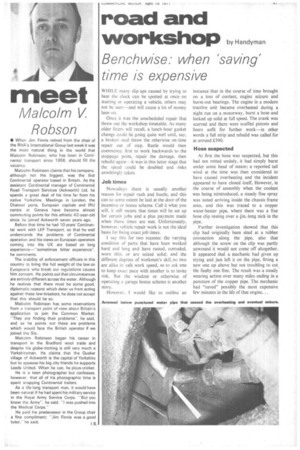road and
Page 43

If you've noticed an error in this article please click here to report it so we can fix it.
workshop by Handyman
Benchwise.. when 'saving' time is expensive
WI [ILE many slip ups caused by trying to beat the clock can he spotted at once on starting or operating a vehicle, others may not be seen--and will cause a lot of money later on.
Once it was the unscheduled repair that threw out the workshop timetable. As many older fitters will recall, a lunch-hour gasket change could be going quite well until, say, a broken stud threw the otherwise on time repair out of step. Battle would then commence, first to work backwards to the stoppage point, repair the damage, then rebuild again-it was in this latter stage that the speed could be doubled and risks unwittingly taken.
Job times Nowadays there is usually another reason for repair rush and bustle, and this can to some extent be laid at the door of the incentive or bonus scheme. Call it what you will, it still means that times will be set up for certain jobs and a plus payment made when those times are met. Unfortunately, however, vehicle repair work is not the ideal basis 11-r fixing exact job times.
I say this for two reasons: the varying condition of parts that have been worked hard and long and have rusted, corroded, worn thin, or are seized solid; and the different degrees of workmen's skill, no two are alike in safe work speed, so to ask one to keep exact pace with another is to invite risk. But the wisdom or otherwise of operating a garage bonus scheme is another story.
However, I would like to outline an instance that in the course of time brought on a loss of coolant, engine seizure and burnt-out bearings. The engine in a modern tractive unit became overheated during a night run on a motorway, burst a hose and locked up solid at full speed. The crank was scarred and there were scuffed pistons and liners unfit for further work—in other words a full strip and rebuild was called for at around £390.
Hose suspected
At first the hose was suspected, but this had not rotted unduly, it had simply burst under some head of steam; a reported tail wind at the time was then considered to have caused overheating and the incident appeared to have closed itself, However, in the course of assembly when the coolant was being reintroduced, a steady fine spray was noted arriving inside the chassis frame area, and this was traced to a copper water-heater pipe, where there was a free hose clip resting over a lin.-long nick in the pipe.
Furtherinvestigation showed that this clip had originally been sited at a rubber connection along the pipe. also that although the screw on the clip was partly unwound it would not come off altogether. It appeared thai a mechanic had given up trying and just left it on the pipe, fitting a new one up above but not troubling to cut, the faulty one free. The result was a steady wearing action over many miles ending in a puncture of the copper pipe. The mechanic had "saved' possibly the most expensive few minutes in the life of that engine...




























































































